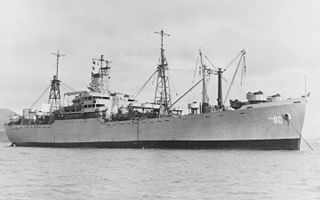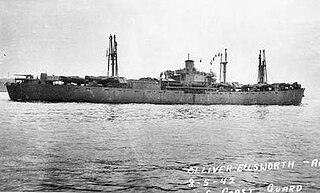
SS A. J. Cermak was a Liberty ship built in the United States during World War II. She was named after Anton Cermak, an American politician. Cermak was the Mayor of Chicago from 1931 until his assassination in 1933 while meeting with President Franklin D. Roosevelt.
SS Benjamin Harrison was a Liberty ship built in the United States during World War II. She was named after Benjamin Harrison, an American planter and merchant, a revolutionary leader, and a Founding Father of the United States. She served a year from March 1942 to March 1943, when she was attacked and scuttled.

Type C2 ships were designed by the United States Maritime Commission (MARCOM) in 1937–38. They were all-purpose cargo ships with five holds, and U.S. shipyards built 328 of them from 1939 to 1945. Compared to ships built before 1939, the C2s were remarkable for their speed and fuel economy. Their design speed was 15.5 knots (28.7 km/h), but some could make 19 knots (35 km/h) on occasion. The first C2s were 459 feet (140 m) long, 63 feet (19 m) broad, and 40 feet (12 m) deep, with a 25-foot (8 m) draft. Later ships varied somewhat in size. Some, intended for specific trade routes, were built with significant modifications in length and capacity.
SS George Calvert was a Liberty ship built in the United States during World War II. She was named after George Calvert, an English politician and colonizer. Calvert took an interest in the British colonization of the Americas, becoming the proprietor of the Province of Avalon, the first sustained English settlement on the southeastern peninsula on the island of Newfoundland. He later sought a new royal charter to settle the region, which would become the state of Maryland.

SS Oliver Ellsworth was a Liberty ship built in the United States during World War II. She was named after Founding Father Oliver Ellsworth, an American lawyer, judge, politician, and diplomat. He was a framer of the United States Constitution, a United States senator from Connecticut, and the third Chief Justice of the United States.
SS William Grayson was a Liberty ship built in the United States during World War II. She was named after William Grayson, a soldier, lawyer, and statesman from Virginia. Grayson was a delegate to the Confederation Congress from 1785 to 1787. He helped to pass the Northwest Ordinance, including a provision that forbade slavery in the Northwest Territory. He was one of the first two US Senators from Virginia, and belonged to the Anti-Federalist faction, he was also the first member of the United States Congress to die while holding office.
SS Roger B. Taney was a Liberty ship built in the United States during World War II. She was named after Roger B. Taney, who was the fifth Chief Justice of the Supreme Court, holding that office from 1836 until his death in 1864. Prior to joining the Supreme Court, Taney served as the United States Attorney General and United States Secretary of the Treasury under President Andrew Jackson.
SS Joseph V. Connolly was a Liberty ship built in the United States during World War II. She was named after Joseph V. Connolly.
SS Henry B. Plant was a Liberty ship built in the United States during World War II. She was named after Henry B. Plant, an American businessman, entrepreneur, investor involved with many transportation interests and projects, mostly railroads, in the southeastern United States. In the 1880s, most of his accumulated railroad and steamship lines were combined into the Plant System, which later became part of the Atlantic Coast Line Railroad.
SS John Randolph was a Liberty ship built in the United States during World War II. She was named after John Randolph, was a planter and a Congressman from Virginia, serving in the House of Representatives at various times between 1799 and 1833, and the Senate from 1825 to 1827. He was also Minister to Russia under President Andrew Jackson in 1830.
SS Christopher Newport was a Liberty ship built in the United States during World War II. She was named after Christopher Newport, who was an English seaman and privateer. He is best known as the captain of Susan Constant, the largest of three ships which carried settlers for the Virginia Company, in 1607, on the way to found the settlement at Jamestown, in the Virginia Colony, which became the first permanent English settlement in North America. He was also in overall command of the other two ships on that initial voyage, in order of their size, Godspeed and Discovery.
SS John Witherspoon was a Liberty ship built in the United States during World War II. She was named after John Witherspoon, a Scottish-American Presbyterian minister and a Founding Father of the United States. Politically active, Witherspoon was a delegate from New Jersey to the Second Continental Congress and a signatory to the United States Declaration of Independence. Later, he signed the Articles of Confederation and supported ratification of the Constitution. In 1789 he was convening moderator of the First General Assembly of the Presbyterian Church in the United States of America.
SS Richard Bland was a Liberty ship built in the United States during World War II. She was named after Richard Bland, an American planter and statesman from Virginia. He served for many terms in the House of Burgesses, was a delegate to the Continental Congress in 1774 and 1775, and is considered a Founding Father of the United States.
SS Thomas Nelson was a Liberty ship built in the United States during World War II. She was named after Thomas Nelson, an American planter, soldier, and statesman from Yorktown, Virginia. He represented Virginia in the Continental Congress and was its Governor in 1781. He is regarded as one of the Founding Fathers of the United States. He signed the United States Declaration of Independence as a member of the Virginia delegation and fought in the militia during the Siege of Yorktown.
SS Thomas Ruffin was a Liberty ship built in the United States during World War II. She was named after Thomas Ruffin, an American jurist and Justice of the North Carolina Supreme Court from 1829 to 1852 and again from 1858 to 1859. He was Chief Justice of that Court from 1833 to 1852.
SS John Carter Rose was a Liberty ship built in the United States during World War II. She was named after John Carter Rose, a United States circuit judge of the United States Court of Appeals for the Fourth Circuit and previously was a United States District Judge of the United States District Court for the District of Maryland.
SS Thomas McKean was a Liberty ship built in the United States during World War II. She was named after Founding Father Thomas McKean, an American lawyer and politician from New Castle, in New Castle County, Delaware and Philadelphia. During the American Revolution, he was a delegate to the Continental Congress, where he signed the Continental Association, United States Declaration of Independence, and Articles of Confederation. McKean served as a President of Congress. He was at various times a member of the Federalist and Democratic-Republican parties. McKean served as President of Delaware, Chief Justice of Pennsylvania, and Governor of Pennsylvania. He is also known for holding many public positions.
SS Pierce Butler was a Liberty ship built in the United States during World War II. She was named after Pierce Butler, a South Carolina, rice planter, slaveholder, politician, an officer in the American Revolutionary War, and one of the Founding Fathers of the United States. He served as a state legislator, a member of the Congress of the Confederation, a delegate to the 1787 Constitutional Convention, and a member of the United States Senate.
SS Will Rogers was a Liberty ship built in the United States during World War II. She was named after Will Rogers, an American stage and film actor, vaudeville performer, cowboy, humorist, newspaper columnist, and social commentator from Oklahoma.
Sword Line Inc. was a steamship company founded by Charilaos "Charles" G. Poulacos and Abbott Abercrombie in New York City in 1933. Sword Line Inc. had shipping routes from Atlantic ports to and Gulf of Mexico ports. Charilaos "Charles" G. Poulacos and Abbott Abercrombie purchased the ship Eastern Sword in 1932. The Eastern Sword was a 3,785-ton cargo ship built in 1920 at the Uraga Dry Dock Co. Ltd, at Uraga, Japan. The ship sank after being hit by a torpedo from German submarine U-162 on May 4, 1942 twelve miles (19 km) off the coast of Georgetown, Guyana. The Eastern Sword had a crew of 38 and only 13 survived the attack. Sword Line Inc. was active in supporting the World War II effort.



